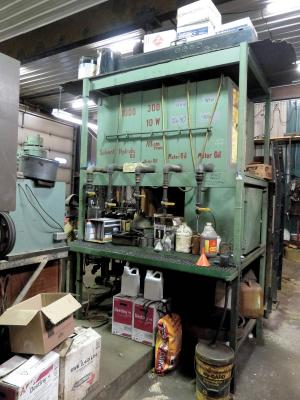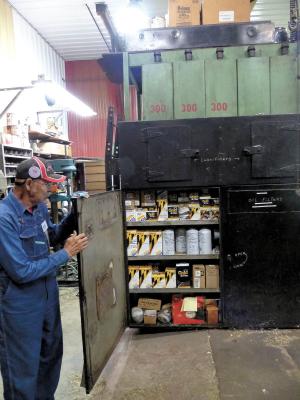Orderly Oil Change Setup
Overhead oil tanks, drip collectors and organized filters keep Howard Ewen’s shop clean and neat, making oil changes a lot easier. With 4 IH 4586 diesels, around 30 Olivers, 5 or 6 farm trucks, 3 pickups and several pieces of homemade equipment, he goes through a lot of oil and filters.
“I have five 75-gal. oil tanks mounted on a rack above my head with a fill cabinet for pitchers and 2 1/2-gal. jugs mounted at one end of the rack,” says Ewen. “Rack space at the other end holds a case of transmission fluid, ether windshield washer fluid, and other liquids.”
Like most farmers, Ewen used to keep his oil in barrels with a hand pump on each. When he had a chance to pick up an old service truck bed with the tanks on it, he grabbed it.
“I have 4 tanks filled with different types of oil and one filled with solvent,” explains Ewen.
A 2-in. outlet on the bottom front corner of each tank has an elbow with a 1 1/2-in. reducer on it and pipes that lead to ball valves above a fill shelf. The shelf is expanded metal with a catch tray beneath to collect drips and spills.
“Any drips from ball valves or containers drain into a 5-gal. bucket and are used for oiling parts,” says Ewen. “Even a few drops at a time count up, and it keeps the shop clean.”
The fill cabinet doors are sealed with rubber foam to keep dust from collecting on the pitchers and jugs.
A large steel cabinet nearly 7 ft. tall and the width of the rack does double duty as filter storage and as a walkway for filling the oil tanks. A ladder on one end gives Ewen easy access. When one of the tanks runs out, he retrieves a barrel from nearby storage and lifts it into position above the tanks with his shop hoist.
“I made a harness for the barrel so it tips it forward,” says Ewen. “Each tank has a 2-in. inlet on it at the rear. I lower the barrel’s faucet end into the inlet pipe and open it up. Once I loosen the bung, it empties out quickly.”
Ewen’s wife Pat maintains inventory on the filters. When a filter is used, a slip of paper is filled out with the filter number and the date and dropped in a box. When filters go on sale locally, Pat pulls the slips and determines how many filters of various types are needed.
“We usually keep around 100 on hand,” notes Ewen. “Having a place for them and always having them on hand makes maintenance of equipment easier to do.”
Contact: FARM SHOW Followup, Howard Ewen, Jr., 6997 W State Rd. 8, Lacrosse, Ind. 46348 (ph 219 754-2365).

Click here to download page story appeared in.
Click here to read entire issue
Orderly Oil Change Setup FARM SHOP Miscellaneous Overhead oil tanks drip collectors and organized filters keep Howard Ewen’s shop clean and neat making oil changes a lot easier With 4 IH 4586 diesels around 30 Olivers 5 or 6 farm trucks 3 pickups and several pieces of homemade equipment he goes through a lot of oil and filters “I have five 75-gal oil tanks mounted on a rack above my head with a fill cabinet for pitchers and 2 1/2-gal jugs mounted at one end of the rack ” says Ewen “Rack space at the other end holds a case of transmission fluid ether windshield washer fluid and other liquids ” Like most farmers Ewen used to keep his oil in barrels with a hand pump on each When he had a chance to pick up an old service truck bed with the tanks on it he grabbed it “I have 4 tanks filled with different types of oil and one filled with solvent ” explains Ewen A 2-in outlet on the bottom front corner of each tank has an elbow with a 1 1/2-in reducer on it and pipes that lead to ball valves above a fill shelf The shelf is expanded metal with a catch tray beneath to collect drips and spills “Any drips from ball valves or containers drain into a 5-gal bucket and are used for oiling parts ” says Ewen “Even a few drops at a time count up and it keeps the shop clean ” The fill cabinet doors are sealed with rubber foam to keep dust from collecting on the pitchers and jugs A large steel cabinet nearly 7 ft tall and the width of the rack does double duty as filter storage and as a walkway for filling the oil tanks A ladder on one end gives Ewen easy access When one of the tanks runs out he retrieves a barrel from nearby storage and lifts it into position above the tanks with his shop hoist “I made a harness for the barrel so it tips it forward ” says Ewen “Each tank has a 2-in inlet on it at the rear I lower the barrel’s faucet end into the inlet pipe and open it up Once I loosen the bung it empties out quickly ” Ewen’s wife Pat maintains inventory on the filters When a filter is used a slip of paper is filled out with the filter number and the date and dropped in a box When filters go on sale locally Pat pulls the slips and determines how many filters of various types are needed “We usually keep around 100 on hand ” notes Ewen “Having a place for them and always having them on hand makes maintenance of equipment easier to do ” Contact: FARM SHOW Followup Howard Ewen Jr 6997 W State Rd 8 Lacrosse Ind 46348 ph 219 754-2365
To read the rest of this story, download this issue below or click
here to register with your account number.








